
A cocktail is an alcoholic mixed drink. Most commonly, cocktails are either a single spirit or a combination of spirits mixed with other ingredients, such as juices, flavored syrups, tonic water, shrubs, and bitters. Cocktails vary widely across regions of the world, and many websites publish both original recipes and their own interpretations of older and more famous cocktails.
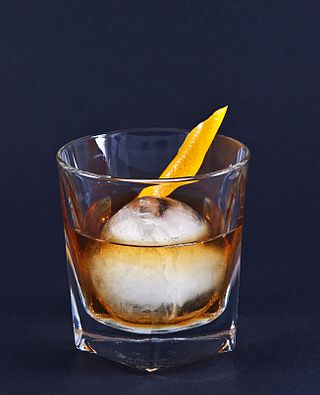
The old fashioned is a cocktail made by muddling sugar with bitters and water, adding whiskey, and garnishing with an orange slice or zest and a cocktail cherry. It is traditionally served with ice in an old fashioned glass.
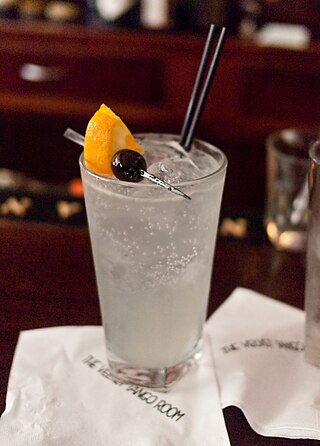
The Tom Collins is a Collins cocktail made from gin, lemon juice, sugar, and carbonated water. First memorialized in writing in 1876 by Jerry Thomas, "the father of American mixology", this "gin and sparkling lemonade" drink is typically served in a Collins glass over ice. A non-alcoholic "Collins mix" mixer is produced, enjoyed by some as a soft drink.

The Sazerac is a local variation of a cognac or whiskey cocktail originally from New Orleans, named for the Sazerac de Forge et Fils brand of cognac brandy that served as its original main ingredient. The drink is most traditionally a combination of cognac or rye whiskey, absinthe, Peychaud's Bitters, and sugar, although bourbon whiskey is sometimes substituted for the rye and Herbsaint is sometimes substituted for the absinthe. Some claim it is the oldest known American cocktail, with origins in antebellum New Orleans, although drink historian David Wondrich is among those who dispute this, and American instances of published usage of the word cocktail to describe a mixture of spirits, bitters, and sugar can be traced to the dawn of the 19th century.

The martini is a cocktail made with gin and vermouth, and garnished with an olive or a lemon twist. Over the years, the martini has become one of the best-known mixed alcoholic beverages. A popular variation, the vodka martini, uses vodka instead of gin for the cocktail's base spirit.
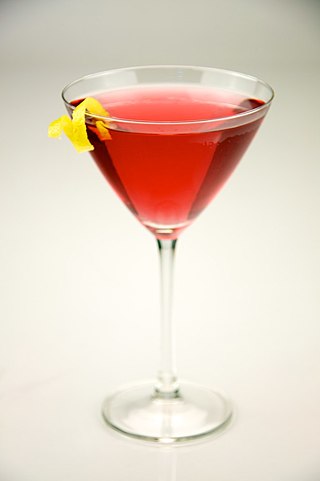
A cosmopolitan, or, informally, a cosmo, is a cocktail made with vodka, Cointreau, cranberry juice, and freshly squeezed or sweetened lime juice.

A bartender is a person who formulates and serves alcoholic or soft drink beverages behind the bar, usually in a licensed establishment as well as in restaurants and nightclubs, but also occasionally at private parties. Bartenders also usually maintain the supplies and inventory for the bar. As well as serving beer and wine, a bartender can generally also mix classic cocktails such as a Cosmopolitan, Manhattan, Old Fashioned, and Mojito.

A flaming drink is a cocktail or other mixed drink that contains flammable, high-proof alcohol, which is ignited before consumption. The alcohol may be an integral part of the drink, or it may be floated as a thin layer across the top of the drink. The flames are mostly for dramatic flair. However, in combination with certain ingredients, the flavor of the drink is altered. Some flavors are enhanced, and the process may impart a toasted flavor to some drinks.

A flip is a class of mixed drinks. According to the Oxford English Dictionary, the term was first used in 1695 to describe a mixture of beer, rum, and sugar, heated with a red-hot iron. The iron caused the drink to froth, and this frothing engendered the name. Over time, eggs were added and the proportion of sugar increased, the beer was eliminated, and the drink ceased to be served hot.
The brandy daisy is a cocktail which first gained popularity in the late 19th century. One of the earliest known recipes was published in 1876 in the second edition of Jerry Thomas's The Bartenders Guide or How To Mix Drinks: The Bon-Vivants Companion:
Fill glass half full of shaved ice. Shake well and strain into a glass, and fill up with Seltzer water from a syphon.

A "fizz" is a mixed drink variation on the older sours family of cocktail. Its defining features are an acidic juice and carbonated water. It typically includes gin or rum as its alcoholic ingredient.

A champagne cocktail is an alcoholic cocktail made with sugar, Angostura bitters, Champagne, brandy, and a maraschino cherry as a garnish. It is one of the IBA official cocktails. Other variations include Grenadine, Orange bitters, Cognac or Sparkling wine. Other nonofficial garnishes include strawberries or dried orange slices.
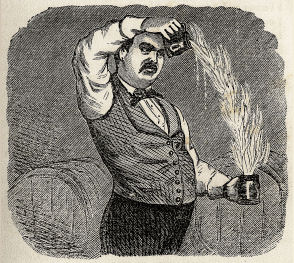
Jeremiah "Jerry" P. Thomas was an American bartender who owned and operated saloons in New York City. Because of his pioneering work in popularizing cocktails across the United States as well, he is considered "the father of American mixology". In addition to writing the seminal work on cocktails, Bar-Tender's Guide, Thomas displayed creativity and showmanship while preparing drinks and established the image of the bartender as a creative professional. As such, he was often nicknamed "Professor" Jerry Thomas.
Old Tom Gin is a gin recipe popular in 18th-century England. In modern times, it became rare but has experienced a resurgence in the craft cocktail movement. It is slightly sweeter than London Dry, but slightly drier than the Dutch Jenever, thus is sometimes called "the missing link".
Boker's Bitters was a brand of bitters manufactured by the L. J. Funke Company of New York City. The ingredient is specified in nearly every cocktail that called for bitters in Jerry Thomas' 1862 book, How to Mix Drinks or The Bon Vivant's Companion. Among the ingredients were quassia, cardamom, and bitter orange peel.
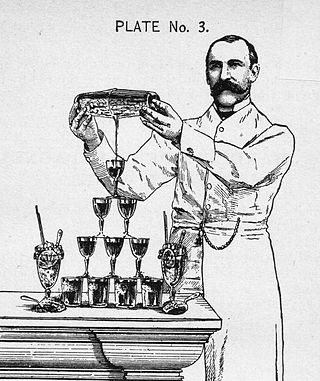
Harry Johnson was an American bartender who owned and operated saloons across the US in the late 19th century and the early 20th century. He is best known for the New and Improved Bartenders' Manual, an influential book that contained many original cocktail recipes, as well as the first written recipes of such cocktails as the marguerite and a version of the martini. Perhaps even more importantly, it was the first book to offer bar management instructions. Johnson opened the first ever consulting agency for bar management. Imbibe magazine has called him one of the most influential cocktail personalities of the last 100 years, and he has been called "the father of professional bartending".

A brandy crusta is an IBA Official Cocktail made of brandy, Maraschino Luxardo, curaçao, fresh lemon juice, sugar syrup, and Angostura bitters.
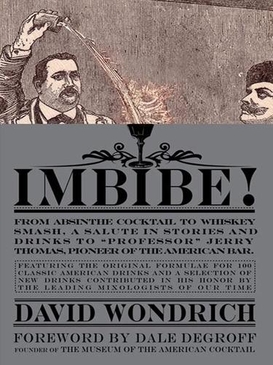
Imbibe! is a book by cocktail historian David Wondrich. It was first published in November 2007 by Perigee Books.

The craft cocktail movement is a social movement spurred by the cocktail renaissance, a period of time in the 21st century characterized by a revival and re-prioritization of traditional recipes and methods in the bar industry, especially in the United States. The renaissance spanned from 2004 into the late 2010s. By 2017, high-quality ingredients, techniques, and liquors began to be ubiquitous in bars across the United States, leading writers to declare the renaissance over.
















